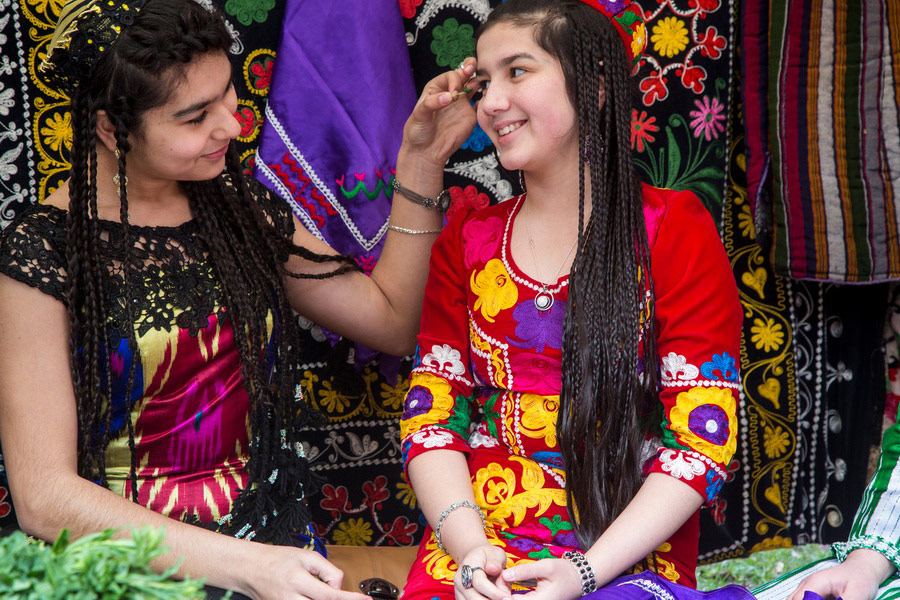Tajik National Clothing

Tajik national clothing is an unmistakable symbol of Tajikistan culture which can still be seen today at national festivals, in museums and in the villages which dot the countryside. Local clothing is defined by myriads of bright colours, straight lines and a loose cut that hides the contours of the body.
While each region of Tajikistan has its own colour preferences and unique fabric patterns, the cut and style selection are the same throughout the country, consisting of tunic-like shirts and dresses, wide-legged trousers and robes. When wearing a head covering, men will generally don a skullcap or turban and women a scarf. Most clothes are made from cotton, silk or a Tajik fabric called alocha, which is striped, multi-coloured and made from a blend of cotton and silk.
Tajik Men's Clothing
Tajik national clothing for men consists of pants, a shirt, a chapan robe, belt and a turban or skullcap, with the quality of each article an indication of the man’s wealth and status. Today, the chapan is still worn by men at significant events such as weddings and funerals and may be presented as a gift on special occasions.
Various types of shirts are worn by men in Tajikistan, but they are usually all cut from one large piece of fabric. The Tajik shirt is wide and worn untucked, sometimes with a belt or scarf. Some of the most common types of shirts are the kurta, kiftaki and kuilak. Tajik trousers, called ishton or ezor, are wide legged but taper around the ankle.
According to Tajikistan custom, the belt worn by men was an indicator of status. Poor people wore a twisted scarf with modest embroidery called a miyonband, while the rich wore a kamarband, a velvet belt decorated with gold-threaded embroidery. The belts would also conveniently double as pockets.
The Tajik chapan is a striped and loose-fitting robe which is adorned with braids that run along the collar, sleeves and hem. Modern chapans are usually made of velvet, although in mountainous areas they are spun from wool. The winter version is quilted and padded.
When wearing both folk costumes and modern clothing, men in Tajikistan will sometimes don a skullcap or a turban, the latter of which is tied over the skullcap or a special kulokh hat. Local skullcaps come in two types: chusti, a dense black-and-white skullcap with various patterns, and knitted, coloured caps called arakhchin. In winter, Tajik men opt for warm and practical fur hats.
Tajik Women's Clothing
Traditional Tajikistan women’s clothing consists of a dress, trousers, robe and a headdress, although in prior centuries a burqa was also obligatory. The decorative elements and method of tailoring each article was important, for this was used to reveal the woman’s social status.
Tajik dresses, called kurta, are long with embroidered, flared sleeves. The shape of the collar depended on the marital status of the woman: unmarried women wore dresses with a horizontal collar cut, and married women with a vertical cut. Although a white dress worn under the main dress served as an undergarment, the white collar had to be visible. Under the dress women still often wear wide trousers called ezor, lozimi, or poijoma.
Women sometimes wear a quilted outer robe called a tsoma, which is very similar to the men's chapan. A slightly lighter form of this robe is the munisak, which differs in cut and is made from silk.
Tajik women usually wear one of three variations of headdress: a turban, a hat or a lachak shawl, all three of which can be worn either separately or at the same time. Sometimes young girls also wear skullcaps.
Tajik Footwear
Footwear is an important element of Tajikistan’s national costume. The most common footwear for Tajiks are the soft makhsi boots which are worn together with kolosh. Ichigi boots are made of goat skin and valued for their durability, and as such they are also popular in the cities. In rural areas, people sometimes wear a high-heeled version of makhsi boots as well as wooden shoes called kafshi chubin. Kafshi Chubin look like a sophisticated version of European clogs, with the addition of two supporting heels close to the toe and one at the heel.
Today in Tajikistan, modern clothes which are stylized according to traditional culture are gaining popularity. For example, traditional Tajik accessories or classic wardrobe items such as the chapan or skullcap will be added to a 21st-century outfit. Although national clothing styles are subtly being transformed under the influence of global trends, Tajik national clothing will always remain a symbol of local culture.

